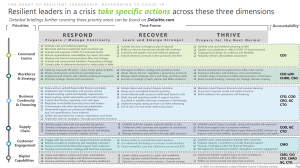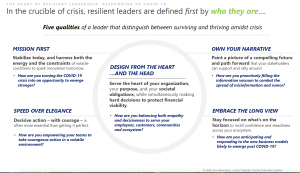By Ray Williams
April 30, 2020

Carol Kaufman, a psychologist and leadership coach at Harvard Medical School says “We are now living and leading in an invisible firestorm that surrounds us. Some of us have been socially distanced or isolated and are fairly protected.” Individual and organizational resilience is now of critical importance.
A recent survey in the Boston Globe reveals that about 20% of us are more frightened than we have ever been in our lives. Another 20% report they are extremely fearful. The virus has a contagion of around 50%. Fear is nearly 100% contagious.

Defining Resilience
The word ‘resilience’ was derived from the Latin resilio (resilı´re), whichmeant ‘‘to jump back.’’ First used in physics and mathematics, resilience described how materials resumed their shape after movement.
Resilience can also be defined as behaviors that “promote personal assets and protecting self from the potential negative effects of stressors.” The American Psychological Association (APA,) defines resilience as “the process of adapting well in the face of adversity, trauma, tragedy, threats or even significant sources of stress.”
In simpler terms, psychological resilience is the ability to mentally or emotionally cope with a crisis or to return to pre-crisis status quickly. Resilience exists when the person uses “mental processes and exists in people who develop psychological and behavioral capabilities that allow them to remain calm during crises/chaos and to move on from the incident without long-term negative consequences.”
Resilience is generally thought of as a positive adaptation after a stressful or adverse situation. When a person is bombarded by daily stress, it disrupts their internal and external sense of balance, presenting challenges as well as opportunities. However, the routine stressors of daily life can have positive impacts which promote resilience. It is still unknown what the correct level of stress is for each individual. Some people can handle greater amounts of stress than others. Resilience is the integrated adaptation of physical, mental and spiritual aspects in a set of “good or bad” circumstances, a coherent sense of self that is able to maintain normative developmental tasks that occur at various stages of life.
The Children’s Institute of the University of Rochester explains that “resilience research is focused on studying those who engage in life with hope and humor despite devastating losses”. It is important to note that resilience is not only about overcoming a deeply stressful situation, but also coming out of the said situation with “competent functioning”. Resiliency allows a person to rebound from adversity as a strengthened and more resourceful person. Researcher Aaron Antonovsky stated when an event is appraised as comprehensible (predictable), manageable (controllable), and somehow meaningful (explainable) a resilient response is more likely.
In all these instances, resilience is best understood as a process. However, it is often mistakenly assumed to be a trait of the individual, an idea more typically referred to as “resiliency”. Most research now shows that resilience is the result of individuals being able to interact with their environments and the processes that either promote well-being or protect them against the overwhelming influence of risk factors. It is essential to understand the process or this cycle of resiliency. When people are faced with an adverse condition, there are three ways in which they may approach the situation. They may:
- Erupt with anger.
- Implode with overwhelming negative emotions, go numb, and become unable to react.
- Simply become upset about the disruptive change.
Only the third approach promotes well-being. It is employed by resilient people, who become upset about the disruptive state and thus change their current pattern to cope with the issue. The first and second approaches lead people to adopt the victim role by blaming others and rejecting any coping methods even after the crisis is over. These people prefer to instinctively react, rather than respond to the situation. Those who respond to the adverse conditions by adapting themselves tend to cope, spring back, and halt the crisis. Negative emotions involve fear, anger, anxiety, distress, helplessness, and hopelessness which decrease a person’s ability to solve the problems they face and weaken a person’s resiliency. Constant fears and worries weaken people’s immune system and increase their vulnerability to illnesses.
Resilience processes include individual continuous coping strategies, or may be helped by a protective environment like good families, schools, communities, and social policies that make resilience more likely to occur. In this sense resilience occurs when there are cumulative protective factors. These factors are likely to play a more important role, the greater the individual’s exposure to cumulative risk factors.
Studies show that there are several factors which develop and sustain a person’s resilience:
- The ability to make realistic plans and being capable of taking the steps necessary to follow through with them.
- Confidence in one’s strengths and abilities.
- Communication and problem-solving skills.
- The ability to manage strong impulses and feelings.
Resilience is negatively correlated with personality traits of neuroticism and negative emotionality, which represents tendencies to see and react to the world as threatening, problematic, and distressing, and to view oneself as vulnerable. Positive correlations stands with personality traits of openness and positive emotionality, that represents tendencies to engage and confront the world with confidence in success and a commitment to self-directedness.
The Role of Positive Emotions
There is significant research found in scientific literature on the relationship between positive emotions and resilience. Studies show that maintaining positive emotions whilst facing adversity promote flexibility in thinking and problem solving. Positive emotions serve an important function in their ability to help an individual recover from stressful experiences and encounters. Maintaining a positive emotionality aids in counteracting the physiological effects of negative emotions. It also facilitates adaptive coping, builds enduring social resources, and increases personal well-being.
The formation of conscious perception and the monitoring of one’s own emotional state is considered a stabile aspect of positive emotions. This is not to say that positive emotions are merely a by-product of resilience, but rather that feeling positive emotions during stressful experiences may have adaptive benefits in the coping process of the individual. Empirical evidence for this prediction arises from research on resilient individuals who have a propensity for coping strategies that concretely elicit positive emotions, such as benefit-finding and cognitive reappraisal, humor, optimism, and goal-directed problem-focused coping. Individuals who tend to approach problems with these methods of coping may strengthen their resistance to stress by allocating more access to these positive emotional resources. Social support from caring adults encouraged resilience among participants by providing them with access to conventional activities.
Positive emotions not only have physical outcomes but also physiological ones. Some physiological outcomes caused by humor include improvements in immune system functioning and increases in levels of salivary immunoglobulin A, a vital system antibody, which serves as the body’s first line of defense in respiratory illnesses. Moreover, other health outcomes include faster injury recovery rate and lower readmission rates to hospitals for the elderly, and reductions in a patient’s stay in the hospital, among many other benefits.
Other Factors Influencing Resilience
A study was conducted among high achieving professionals who seek challenging situations that require resilience. Research has examined 13 high achievers from various professions, all of whom had experienced challenges in the workplace and negative life events over the course of their careers but who had also been recognized for their great achievements in their respective fields. Participants were interviewed about everyday life in the workplace as well as their experiences with resilience and thriving. The study found six main predictors of resilience: positive and proactive personality, experience and learning, sense of control, flexibility and adaptability, balance and perspective, and perceived social support. High achievers were also found to engage in many activities unrelated to their work such as hobbies, exercising, and organizing meet-ups with friends and loved ones.
Several factors are found to modify the negative effects of adverse life situations. Many studies show that the primary factor for the development of resilience is social support. While many competing definitions of social support exist, most can be thought of as the degree of access to, and use of, strong ties to other individuals who are similar to one’s self. Social support requires not only that you have relationships with others, but that these relationships involve the presence of solidarity and trust, intimate communication, and mutual obligationboth within and outside the family. Additional factors are also associated with resilience, like the capacity to make realistic plans, having self-confidence and a positive self image, developing communications skills, and the capacity to manage strong feelings and impulses.
Another protective factor is related to moderating the negative effects of environmental hazards or a stressful situation in order to direct vulnerable individuals to optimistic paths, such as external social support. More specifically a 1995 study distinguished three contexts for protective factors:
- personal attributes, including outgoing, bright, and positive self-concepts.
- the family, such as having close bonds with at least one family member or an emotionally stable parent; and
- the community, such as receiving support or counsel from peers.
How to Build Individual Resilience
The American Psychological Association suggests “10 Ways to Build Resilience”:
- Maintain good relationships with close family members, friends and others.
- Avoid seeing crises or stressful events as unbearable problems;
- Accept circumstances that cannot be changed;
- Develop realisticgoals and move towards them;
- Take decisive actions in adverse situations;
- Look for opportunities of self-discovery after a struggle with loss;
- Develop self-confidence;
- Keep a long-term perspective and consider the stressful event in a broader context;
- Maintain a hopeful outlook, expecting good things andvisualizing what is wished;
- Take care of one’s mind and body, exercising regularly, paying attention to one’s own needs and feelings.
A number of self-help approaches to resilience-building have been developed, drawing mainly on the theory and practice of cognitive behavioral therapy (CBT) and rational emotive behavior therapy (REBT). For example, a group cognitive-behavioral intervention, called the Penn Resiliency Program (PRP), has been shown to foster various aspects of resilience. A meta-analysis of 17 PRP studies showed that the intervention significantly reduces depressive symptoms over time.
Connecting Resilience with Self-Awareness
There’s a paradox which centers on contemplation-and action, a creative tension between knowing one’s true self and choosing actions that are aligned with our deeply held beliefs and values. The one thing we bring to community is ourselves. It is ultimately the best gift we give to others. Therefore, it is imperative that we know ourselves, appreciate our gifts and work toward being truthful and forthright in the actions we take in our lives.
Self-reflection helps us identify the fundamental commitments that make us who we are and that move us toward authentic actions. Knowing our inner life becomes critical, for it improves our relationships. Participating in relationships blindly, without self-examination tends toward habitual, automated actions and reactions that may be driven by our deepest fears and i n securities. Our perceptions become caught up in a system of thought, a homeostatic structure, that is organized around our memories, such that our thinking is influenced by an overriding system of thought which forms our perceptions and the meanings we assign to daily activities. Associated with our memories are emotions, which become hardwired in our consciousness to the extent that we react out of these memories, resulting in a loss of authenticity and freedom. Entering into relationships in a conscious, reflective and mindful manner can lead toward a movement of will and actions that is more authentic and closer to a true sense of being.
Resilience in the Workplace
Resilience has also been examined in the context of failure and setbacks in workplace settings. Representing one of the core constructs of positive organizational behavior and given increasingly disruptive and demanding work environments, scholars’ and practitioners’ attention to psychological resilience in organizations has greatly increased. This research has highlighted certain personality traits, personal resources (e.g., self-efficacy, work-life balance, social competencies), personal attitudes (e.g., sense of purpose, job commitment), positive emotions, and work resources (e.g., social support, positive organizational context) as potential facilitators of workplace resilience.
Beyond studies on general workplace resilience, attention has been directed to the role of resilience in innovative contexts. Due to high degrees of uncertainty and complexity in the innovation process, failure and setbacks are naturally happening frequently in this context. As such failure and setbacks can have strong and harmful effects on affected individuals’ motivation and willingness to take risks, their resilience is essential to productively engage in future innovative activities.
Researcher Zhen Wang and colleagues examined the connection between positive effect and resilience in the workplace. They postulated that highly resilient individuals had more personal resources and were more likely to be engaged at work. They defined positive effect as “high positive activation, including enthusiasm, alertness, and excitement.” Those positive emotions generate long-term personal resources such as well-being.
Another meta-analysis found that high positive affect predicted higher job satisfaction, greater organizational commitment, and lower burnout. According to the broaden-and-build theory, positive emotions broaden individuals’ momentary thought-action repertoires, enhance their psychological resources, decrease their distress, and promote their creative ideas and prosocial actions. Thus, individuals with high positive affect are more inclined to be engaged with their work. Furthermore, highly resilient individuals cope more successfully with stress and negative events and therefore have high levels of positive affect.
Wang further concluded “positive affect may mediate the relationships between resilience, transformational leadership, and work engagement. Transformational leaders may elicit feelings of happiness and enthusiasm in their followers by attending to and supporting their needs and helping them cope with stressors, in turn promoting positive affect.
The findings of the current research also carry practical implications. To promote work engagement, managers can recruit and select highly resilient individuals. An alternative way to increase resilience is to provide resilience training for employees. Because transformational leadership shows promise in promoting work engagement, managers may express more transformational leadership behaviors, such as paying attention to employees’ different needs, depicting idealized visions, and offering social support. Furthermore, the findings suggest that organizations should employ ways to improve employees’ positive affect because doing so will increase satisfaction, improve work engagement, and lead to better organizational effectiveness.
In their research, Danielle King, Alexander Newman and Fred Luthan, writing in the Journal of Organizational Behavior, argued there is growing evidence that resilience can be developed through the use of cognitive transformational and personal growth training.
Ivan Robertson, Cary Cooper, Mustafa Sarkar and Thomas Curran, writing in the Journal of Occupational and Organizational Psychology examined resilience training in the workplace from 2003 to 2014. Among their conclusions were:
- interventions supporting resilience, designed to protect and sustain well-being and performance in the face of adversity, would be likely to deliver benefits for both employees and their organizations.
- mindfulness training and cognitive-behavior interventions seemed to have the greatest success among training strategies.
Laura Delizonna, at Stanford University identified two significant resilience interventions in the workplace that had a significant effect: Developing psychological safety and the focus on a learning organization.
Resilience goes beyond specific responses and implies the existence of organizational resources and capacities that can be actuated when adverse conditions arise. At a basic level, resilience embodies the concept of helping organizational leaders manage the current crisis and build capacity for dealing with future disturbances.Organizational resiliency is an organizational concept intended to improve decision-making by encouraging the diversification of capacities in the organization to be responsive to uncertain future events.
Organizational leaders must develop the capacity of those in the organization to adapt to change. Organizational resilience highlights the capacity of an organization to ‘absorb’ adversity in order to continue organizational functioning and ‘bounce back.’
Resilient organizations encourage innovation and foster a culture of continuous innovation to solve problems and adapt to challenges. Adaptive capacity reflects learning, flexibility to experiment and adopt novel solutions, and development of generalized responses to both internal and external challenges. Ultimately, resilience emphasizes increasing the organization’s ability to withstand crises. Resilient leaders are able to overcome the unexpected because they perceive sustainability as survival and resilience as thriving amid chaos.
Organizational Resilience
Research has shown that resilience can be developed in organizations through the practice of “caring relationships.” Clearly, turbulence and chaos are an enduring feature of modern workplaces. Not only is change occurring at a fast pace in organizations, but also the rules to manage change are changing. At one time change could be managed through rational, linear decision-making models; however, such models are not likely to be effective today since these address only the surface layer of problems, and ignore the deep underlying complexity of issues regarding the change process itself.
Although change occurs at a fast pace in our society, the one thing that has not changed is how individuals psychologically respond and adapt to change. These changes are not as challenging as the process of transitioning, for transitions require an internal psychological and often times emotional process of letting go of the old and welcoming the new, causing a sense of incoherence. The change process is more likely to occur in healthy ways for individuals who are resilient to change, i.e., for those who have the psychological and biological strength required to successfully master change.
In part, resilience can be fostered through relationships, by engaging with other human beings who understand what we are experiencing. Prior research shows that relationships in the workplace can improve our ability to change by simply connecting us to each other, for if we can sit together and talk about what’s important to us, we begin to come alive. We share what we see, what we feel, and we listen to what others see and feel. Several authors emphasize that today’s organizations need an environment that supports the change process, an environment that supports healthy relational practices. Such relational practices emphasize mutual growth and empowerment where vulnerability is recognized as part of the human condition and interactions with others are viewed as opportunities for personal growth on the part of all concerned parties.
Dissolving current structures presents a challenge–the challenge of living in a state of chaos where we question our identity and seek new potentialities within ourselves. While in this state of chaos we may no longer feel our lives are coherent and predictable. William Bridges, who wrote the definitive work on transitions, views chaos positively for it bears new possibilities. According to Bridges, chaos is a primal state that holds the energy we need to reconcile our felt dissonances and to create new beginnings for our lives.
A fourth challenge both individuals and organizations face that can support resilience is to name our new beginnings and reintegrate them into a new homeostatic structure, one that is more mature and life-giving than the old structure that guided our lives in the past. In time, we once again gain a sense of coherence and predictability in our lives. However, reintegration requires continual reevaluation of our thinking and actions to assure we are indeed moving in the intended direction. It is one thing to name new directions, but quite another to actually live them out. Resilience then, can be seen as an ability to see reality, to judge the likelihood of desirable outcomes in view of the countervailing forces operative in all of life.
A critical characteristic of resilience is our ability to form a trusting, collaborative relationship with others, thereby establishing a supportive surrounding in which transformation can occur. The intimacy of friendship allows us to share with our friends who we are, what we value, what gives our life meaning and purpose. As well, it allows us to share our feelings and frustrations, which helps us to process our thinking and to gain from the wisdom of our friends as to how we might move forward in our lives.
The Balance of Autonomy Vs the Need For Community
A paradox central to caring relationships integrates autonomy and community. Autonomy can be defined as being self-determined, having control over our life, and being free of coercion in our decision-making. To ensure we are self-determined and not motivated by social forces, not only must we choose for ourselves, we also must think reflectively and critically about whether choices we make have arisen from our true self. Paradoxically, autonomy also involves a social response, as our unique autonomy stems from interdependence and turns toward community for affirmation and continuation. The deeper our involvement in creative and transformative relationships, the more likely we are to grow and gain a stronger sense of self-empowerment and self-cultivation.
Resilience requires friendships that encourage individual freedom and do not compromise our sense of autonomy; these friendships need to strengthen our autonomy and ability to relate in multiple ways. An important feature of a supportive environment is open communication through which people have the freedom to express what they believe and are willing to give others the same privilege.
Through open communication we are able to share our ideas, hopes, dreams, and disagreements. There is tolerance for conflict, and when disagreements require resolution, we are able to make amends through reconciliation. Open communication creates an environment in which there is ongoing respect for our presence and the presence of others.
If our autonomy is well developed then we are likely to have the strength, courage, and confidence to make decisions about our futures; moreover, in the process of change, when we experience stress and confusion, our autonomy helps to restore our self-esteem. There are times when we must decide and act on our own and at other times we must reach out for support.
Emotional Maturity
Emotional maturity is another crucial characteristic of resilience. Daniel Goleman describes an emotional intelligent person as exhibiting self-awareness, self-management, social awareness, and relationship management; such a person is able to positively manage emotions in times of stress. Emotional maturity means we have the capacity to tolerate pain, we have insight into our own feelings, and we have the ability to communicate our feelings to others. Many of us have difficulty letting go of the past and experiencing chaos. We would much prefer to keep life as it is, with our current homeostatic structures in place. However, resilience may require us to let go of the past and a process of dissolving and reintegrating must be experienced, regardless of the pain involved. Resilience means we are able to recognize pain, acknowledge its purpose, and tolerate it for a reasonable time until it begins to take shape and resolve our conflicts constructively, Goleman says.
Caring Relational Practices
Individuals who engage in caring relationships as a way to enhance resilience because caring relationships involve a dynamic interplay of self and others, a human tendency that expresses our desire to help ourselves and others with the intention of promoting life. Caring in this sense goes beyond conventional descriptions of caring such as wishing well, liking, comforting and maintaining, or simply having an interest in what happens to another. Rather, the transformative character of caring touches the core of our existence as a human being. Researches have described caring with love and explain that this love is not sentimental in nature; rather it is a love that involves a complex of emotions, attitudes, movements of will and actions in which we reach out to others in a caring, concerned manner, desiring to let people know that we care for them and wish to facilitate the achievement of their potential.” In this way, the love can be described as compassionate love.
Relationships need to be positioned in the forefront of workplace life and intentionally practiced; there needs to be a structure in which such relationships can be lived out, reviewed, and renewed. Caring relational practices are not likely to happen without intentionality, especially in workplaces where relationships are not valued or tend to be negative and hurtful.
The practice of caring relationships in such settings would require interventions to enhance members’ understanding of caring relationship and develop skills needed for full participation. Organizational development approaches for the purpose of establishing caring relationships in the workplace could include process-focused interventions, open systems approaches, or methods involving collaborative inquiry or appreciative inquiry.
Given the importance for workplace members to be committed to this form of relationships, initial development activities should focus on establishing awareness of what caring relationships mean and why they are important, resulting in a shared vision for a desired workplace culture. A second preliminary intervention would be to gain understanding of what it means to live out the paradoxes of autonomy/community and contemplation/action in the workplace.
What Are the Skills of Resilient Leaders?
Margaret Wheatley statedthat resilient leaders must focus on the people involved in the change and not onthe structure of the organization. Resilient leadership calls for a focus on the people expected to work with the change rathert han relying upon a devised system orstructure because there is a tendency for people to get easily overwhelmed when experiencing change.
In addition, resilient leaders embrace the reality of continuous, unpredictable future change, and look for ways to survive the irreversible changes that have occurred. Resilient leaders focus their energy on creating ways to adapt to irrevocable change, and explore ways to anticipate future changes.

Jennifer Garvey Berger in her book, Simple Habits for Complex Times: Powerful Practices for Leaders argues leaders need to aim for shifting mindsets so we can move teams forward, recover quickly from setbacks,and maintain optimism and composure. In a complex and fast-changing world,just snapping back from setbacks isn’t enough to be resilient, she says. Leaders have to adapt and evolve each time they bounce back. Berger arguest he role of a modern resilient leader isn’t just to withstand difficult conditions. It is to learn and improve because of them and anticipate the future.
Kenneth E. Lane, Thomas McCornack and Michael D. Richardson, writing in The International Journal of Organizational Innovation on the topic of leader resilience, contend “In today’s world, resilient leaders look for ways to manage in an imbalanced world where the focus is on leading for resilience, where the future is unpredictable capacity is uncertain and and learning is an issue of social.”

Joseph Folkman contends resilient leaders sees failures temporary setback that they an recover from quickly and they maintain a positive attitude and strong sense of acting on opportunities during periods of turbulence. Folkman says resilient leaders continually find ways of moving forward and avoid getting” stuck.” He identifies, based on a study of 500 leaders a number of ways that leaders can be more resilient, among them:
- Communicate Powerfully: Some individuals will often act individually and not inform others about what they are trying to do. They were willing to help others understand a new strategy or direction. Effective communication helps others understand changes, expectations and new directions.
- Are Coachable: Resilient leaders are open to feedback and often asked others for feedback. Once feedback is given they also demonstrate a real effort to improve. They have a strong desire to continuously improve their skills and abilities. These leaders were both humble and coachable.
- Build Positive/Trusting Relationships: Resilient leadership occurs when people can bring others along. By building trust and being open to differences, these leaders are able to create strong teams by building positive relationships. An individual may be willing to make a dramatic change, but it requires positive relationships to get others to support change.
- Are Bold Risk Takers: Resilient individuals are willing to take bold risks and try new ideas. It is easy for most individuals to be stuck in a rut in which they continue to conduct work in the same way from year to year. That approaches works well until the world changes, requiring organizations to change or die. Resilient leaders are not afraid to take risks and make bold changes.
- Develop Others: The most resilient leaders are not only interested in their own development but they are concerned about the development of others. Resiliency is needed when we encounter failure. Developing others helps everyone to learn from their mistakes. Leaders who want feedback for themselves are more likely to give productive feedback and coaching to others, because they want honest feedback as well.
- Champion Change: Resilient leaders are willing to change and able to provide the leadership to ensure that the organization will also change. Change takes courage and requires a vision about where the organization is going. Resilient leaders embrace change and also encourage others to change.
- Are Decisive: Making decisions is always difficult because no person has all the data or understands all eventualities. But organizations cannot move forward until a decision gets made. The most resilient leaders are effective at making decisions and moving forward. If they make the wrong decision, they are quick to make a different decision and move in another direction. The proverb by Cato “Swift and resolute action leads to success; self-doubt is a prelude to disaster” fits well here.
A Harvard study of leadership studies identified authenticity as the top leadership success factor, followed by vulnerability, intuitive thinking and decision making, and tough empathy. We have also learned that behaviors like promise keeping and trusting, respectful, fair treatment are fundamental to engaged and mentally healthy employees. Emotional competencies like knowing oneself and managing relationships underlie these behaviors. The connections are obvious…so too the proven correlation with client satisfaction, which drives business results. Our interviewees reinforced these findings.
Summary:
Rapid, disruptive change is today’s normal. It comes in bubbles, waves and sometimes tsunamis such as the virus pandemic. To cope, leaders need to be agile and resilient. For years, the focus has been on speed and agility. But globalization, technology and social-political changes are disruptive. They require resilient leaders, emotionally intelligent people able to absorb complex change and help others move forward to achieve success. And organizations need to build structure and processes to facilitate and build resilience strength and capacity.
Copyright: Neither this article or a portion thereof may be reproduced in any print or media format without the express permission of the author.
Read my latest book:
I Know Myself and Neither Do You: How Charisma, Confidence and Pedigree Won’t Take You Where You Want to Go, available in paper and ebook on Amazon and Barnes and Nobel in the U.S., Canada, Europe, Australia and Asia


